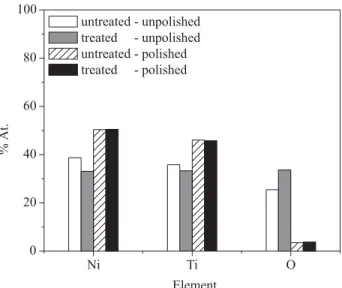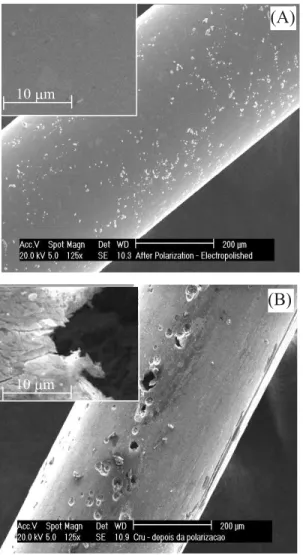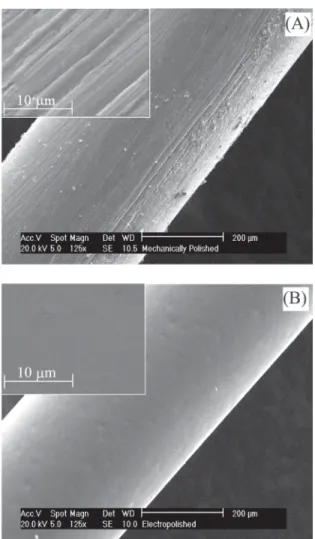0103 - 5053 $6.00+0.00
Article
* e-mail: spin@qmc.ufsc.br
Microstructure and Surface Composition Effects on the Transpassivation of NiTi Wires for
Implant Purposes
Anderson Garbuglio de Oliveira, Fernando Carlos Giacomelli, Cristiano Giacomelli and
Almir Spinelli
*Departamento de Química, Universidade Federal de Santa Catarina, 88040-900 Florianópolis - SC, Brazil
A influência da microestrutura e da composição da camada superficial na transpassivação de fios de NiTi utilizados em implantes endovasculares não tratados e tratados termicamente (500 ºC) foi estudada por métodos eletroquímicos (potencial de circuito aberto e curvas de polarização potenciodinâmica), difração de raios-X (DRX) e microscopia eletrônica de varredura (MEV). O potencial no qual o filme passivo rompe-se (Eb) depende da composição química da camada de óxidos que recobre o eletrodo, assim como da microestrutura do biomaterial. Para as amostras de NiTi não tratadas termicamente, a microestrutura é mais desordenada, porém altamente resistente à transpassivação (Eb ~ 1,00 V/ECS). Entretanto, a presença de um filme nativo rico em oxigênio facilita a sua dissolução (Eb ~ 0,00 V/ECS). Quando tratado termicamente, o biomaterial NiTi torna-se estruturalmente mais ordenado, todavia menos resistente à dissolução (Eb ~ 0,12 V/ECS), sendo que a presença do filme nativo e rico em oxigênio tem pouca influência no valor de Eb (Eb ~ 0,03 V/ ECS) neste caso.
The microstructure and surface composition effects on the transpassivation behavior of untreated and heat treated at 500 ºC NiTi wires used for implant purposes were investigated by electrochemical techniques (open circuit potential and potentiodynamic polarization curves), X-ray diffraction (XRD) and scanning electron microscopy (SEM). The potential at which the passive film breaks down (Eb) (transpassivation) was found to be strictly dependent on both the chemical composition of oxide covering layer and the microstructure of the biomaterial. It could be concluded that the disordered microstructure of untreated NiTi is highly resistant to transpassivation (Eb ~ 1.00 V/SCE), but the presence of a native oxygen rich oxide film onto it makes the dissolution easier (Eb ~ 0.00 V/SCE). Upon thermally treating, the microstructure becomes ordered and less resistant to dissolution (Eb ~ 0.12 V/SCE), but in this case the presence of an oxygen rich native film influenced Eb in a lower extent (Eb ~ 0.03 V/SCE).
Keywords: NiTi alloy, electrochemical behavior, artificial saliva, microstructure and surface composition of NiTi alloy
Introduction
Near equiatomic NiTi alloy has become ubiquitous among biomedical materials used as prosthesis due to its mechanical (shape memory and superelasticity) and corrosion resistance properties, and, most importantly, biocompatibility. An overview of the medical applications of NiTi alloys was recently given by Duerig et al.1 Nevertheless, a major concern on the dissolution properties of NiTi alloy still remains owing to the high nickel content, since nickel element has been shown to provoke several
Similar effects could be also obtained by applying TiO2 and TiO2-SiO2 protective coatings viasol-gel,13,14 heat treating,1 electropolishing,15,16 laser surface melting17 and nitriding18 NiTi wires at suitable conditions. All these treatments were found to change the surface composition, thereby improving Eb.
It is well documented in the literature the effects of heat treating NiTi samples on the chemical composition of surfaces,19 and on the alloy microstructure20-22 as well. We have noticed, however, that most of the works have dealt with commercial NiTi wires, whose history is somewhat unknown. Supposedly, the heat treatment (applied by the manufacturer, if any) effects on the chemical composition of the surfaces are initially removed by polishing,7 the film subsequently and spontaneously formed onto the surface or the microstructure being responsible for the final properties. Therefore, it would be meaningful to evaluate the electrochemical properties of implant alloys immediately before they are implanted (shaped into their definitive form through a thermal-mechanical treatment) and unshaped (not thermally treated) in order to distinguish between the microstructure and surface chemical composition effects. Also, an insight into NiTi electrochemical behavior in most unfavorable environmental conditions such as aggressive pH is still required.
In this work, we addressed the questions above characterizing the NiTi electrochemical behavior in a wide range of pH, together with surface analysis by means of SEM, EDS and XRD techniques.
Experimental
Materials
An equiatomic NiTi wire was employed in the experiments. Artificial saliva AFNOR S90-701 (Table 1) was used as working solution and prepared using reagents of analytical grade without previous purification. When it was necessary, the solution pH was adjusted by adding H3PO4 or NaOH dilute solutions.
Electrochemical system
Electrochemical measurements were carried out with an EG&G PAR model 263A potentiostat/galvanostat interfaced with a microcomputer using the EG&G-PAR “SoftCorr II Model 252/352” software for data acquisition and analysis. The electrochemical cell contained five openings: three of them were used for the electrodes and two of them for nitrogen bubbling prior to all the experiments or to keep an inert atmosphere by a flux over the solution also during all the experiments. The counter electrode (CE) was a graphite rod and the reference electrode (RE) was a saturated calomel electrode (SCE) connected to the cell by a salt bridge and a Luggin-Habber capillary. All potentials in the text are quoted to this electrode. The working electrode (WE) was a 0.129 cm2 (geometrical surface area) NiTi wire mounted in a glass tube with Araldite® epoxy. Excepted where indicated, the electrode surface was mechanically or electrochemically polished prior to the experiments. Mechanical polishing was accomplished by employing a 1200 emery paper, whereas to prepare electropolished electrodes the NiTi wires were submitted to polarization at 23 V during 5 sec in a 5/95 (% v/v) HClO4/CH3COOH solution. Following, the electrodes were ultrasonically cleaned, degreased with acetone, rinsed with deionized water and finally dried with a gentle stream of air at room temperature. The potentiodynamic polarization curves were shaped in agreement with the ASTM G5 norm. Electrochemical experiments were performed after an electroreduction process at a fixed potential (EO,c = -1.33 V/SCE) in order to improve the results reproducibility by reducing as much as possible spontaneously formed oxides onto the electrode surface. Excellent reproducibility was achieved when a potentiostatic reduction during 10 min was applied.
Heat treatment was performed in agreement with the usual and previously described procedure applied in the fabrication of NiTi stents.8
Surface analysis
The alloy surface morphology before and after the electrochemical experiments was observed by Scanning Electron Microscopy (SEM) using a Philips XL-30 microscope. Additionally, the alloy surface composition was determined by an Energy Dispersive Spectroscopy (EDS) apparatus coupled to the Philips XL-30 microscope. X-ray Diffraction (XRD) spectra were recorded using a X’Pert Philips spectrometer with Cu-KD radiation.
Table 1. Chemical composition of the AFNOR S90-701 artificial saliva
Chemical Concentration / g L-1
Na2HPO4 0.26
NaCl 6.70
KSCN 0.33
KH2PO4 0.20
KCl 1.20
Results and Discussion
Microstructure effect
Figure 1 shows the open circuit potential (A – C) and potentiodynamic polarization (D – F) curves recorded in artificial saliva AFNOR S90-701 at 37 ºC with pH modified
to 2.0 (A and D), 7.4 (B and E) and 10.4 (C and F) for untreated ( ) and heat treated ({) electropolished NiTi wires. In Figures 1A–C, an OCP displacement towards positive potentials is noticed following the electrode immersion, which remains slowly increasing afterwards. This behavior is characteristic for metals that present spontaneous film formation onto the metallic surface,
which may control and reduce the alloy dissolution. At the end of 60 min, the observed OCP values are pH-dependent. Most importantly in Figures 1A–C is the similarity between curve profiles and OCP values observed for heat treated and untreated samples. On the other hand, a huge difference is perceived in the potentiodynamic polarization curves (Figures 1D–F), where the potential at which the passive film breaks down (Eb) giving to an active dissolution process was markedly lower for heat treated samples than for untreated ones (see also data in Table 2).
Table 2) with, for example, the potentials for pure Ti (0.45 – 0.55 V/SCE), we can conclude that appreciable attention should be given to the transpassivation of equiatomic NiTi wires, provided that depending on the exposure medium and handling procedures (samples history) a very low and dangerous Eb value may be recorded.
Surface composition effect
In order to understand the surface composition effect on the OCP and potentiodynamic polarization profiles, a number of experiments were performed without applying the initial polishing procedure. This approach must be considered worthwhile owing to the fact that NiTi stents are normally implanted into the human body without removing the native covering layer.
Figure 3 shows the surface composition estimated by EDS analysis before electrochemical experiments. Although EDS analysis of thin films may be thickness-sensitive, the results herein definitely also stand for composition changes, given the distinct responses in the OCP measurements, which are thickness-insensitive.25 In Figure 3, among the unpolished samples, the oxygen content was found to be 34% at. for heat treated samples and 26% at. for untreated ones. Upon electrochemical polishing, the oxygen content markedly decreased to ~ 4% at., suggesting that, in the later case, the oxide passive layer likely becomes thin with changes in the surface composition. Presumably, these differences would have implications on the final electrochemical properties. Indeed, the results recorded for polished and unpolished NiTi wires have been found to be deeply distinct. Figure 4 depicts open circuit potential (A) and potentiodynamic
polarization (B) curves recorded in artificial saliva AFNOR S90-701 at 37 ºC pH 7.4 solutions for the same samples as for Figure 3. In Figure 4A, one notices that polished samples (whose oxygen content is low – Figure 3) present essentially the same OCP values (-0.61 V). However, unpolished NiTi wires exhibited somewhat different OCP values at the end of 60 min of immersion (untreated: -0.53 V; treated: -0.36 V). This fact is related to interaction between working solution and electrode surface, which is particular in the later case because of surface composition. Concerning the results in Figure 4B, the heat treated NiTi electrodes exhibited low Eb values independently of whether they were (Eb = 0.12 V) or not (Eb = 0.03 V) electrochemically polished. The untreated – unpolished specimens, on the other hand, showed unexpectedly low Eb values (around 0.00 V) in comparison to the same polished electrode (1.00 V). In order to get insight into
Figure 4. Open circuit potential (A) and potentiodynamic polariza-tion (B) curves recorded in artificial saliva AFNOR S90-701 pH 7.4 solutions at 37 ºC showing the effect of polishing on the resulting curve profile.
this detail, SEM micrographs were taken after transpassivation for both untreated – polished (Figure 5A) and untreated – unpolished (Figure 5B) NiTi wires. The SEM micrograph depicted in Figure 5A corresponds to an essentially unchanged surface, whereas in Figure 5B the electrode surface is shown to be appreciably damaged owing to the active dissolution. The inset in Figure 5B illustrates a pore which seems to indicate that the native oxide covering layer detaches from the wire due to its lack of resistance upon polarization.
Polishing method
Electropolishing is a suitable alternative to attain surface finishing of samples with unusual shapes that are sometimes difficult to handle with, as is the case of NiTi stents (NiTi wires shaped into their definitive form for medical application). However, depending on the experimental conditions (mainly the applied voltage), a
selective electrodissolution can take place, resulting in surface enrichment with a particular element.15,16 Concerning NiTi alloys, it was previously reported that electropolishing can result in Ti-enriched surfaces in comparison to mechanically polished specimens. In this work, however, we have successfully used a procedure to electropolish equiatomic NiTi samples which does not provoke any changes in the surface composition.
Figure 6 shows OCP (A) and potentiodynamic polarization curves (B) for a NiTi stationary electrode immersed in AFNOR S90-701 artificial saliva at 37 ºC with pH modified to 2.0. It has been seen in Figure 6A that the polishing procedure does not affect both OCP profile and OCP values, corroborating that the conditions employed here do not have influence on the surface composition that evolves during immersion.25 In addition, this was further confirmed by EDS which indicated the following % at. for Ni, Ti and O, respectively: 50.4, 46.1 and 3.5
Figure 5. Characteristic SEM micrographs of untreated – polished (A) and untreated – unpolished (B) NiTi wires registered after transpassivation.
(electrochemically polished) and 50.3, 45.9 and 3.8 (mechanically polished). In Figure 6B a higher current density is observed for mechanically polished electrodes in relation to electrochemically polished ones due to the higher surface area of the former, as can be deduced by analyzing the surface conditions in Figure 7A (mechanically polished) and Figure 7B (electrochemically polished). Similar results were also found for solutions with other pH values.
Conclusions
According to our findings, the transpassivation of equiatomic NiTi wires depends not only on the chemical composition of oxide covering layer but also on the microstructure of the material. In the case of NiTi samples not thermally treated, the best result in terms of Eb (the potential at which the passive film breaks down) was recorded when the native oxide covering layer was removed
by polishing. Hence, it can be concluded that the disordered microstructure of untreated NiTi is highly resistant to transpassivation (Eb ~ 1.00 V/SCE), whereas the presence of the native oxygen rich film onto it makes the dissolution thermodynamically easier (Eb ~ 0.00 V/ SCE). Upon thermally treating equiatomic NiTi wires, the microstructure becomes more ordered and less dissolution resistant (Eb ~ 0.12 V/SCE), then comprising the main factor determining the Eb value. In addition, the presence of an oxygen rich native film onto the surface influenced Eb in a less extent (Eb ~ 0.03 V/SCE).
Acknowledgements
The authors are grateful to Nano Endolumial (Brazil) and Conselho Nacional de Desenvolvimento Científico e Tecnológico (CNPq, Brazil) – for financial support. C. Giacomelli whishes to thank to Coordenação de Aperfeiçoamento de Pessoal de Nível Superior (CAPES, Brazil).
References
1. Duerig, T.; Pelton, A.; Stockel, D.; Mater. Sci. Eng. 1999,
A275, 149.
2. Hsu, H. C.; Yen, S. K.; Dent. Mater. 1998,14, 339. 3. Rondelli, G.; Biomaterials1996,17, 2003.
4. Messer, R. L. W.; Lucas, L. C.; Dent. Mater. 2000,16, 207. 5. Rondelli, G.; Vicentini, B.; Biomaterials 2002,23, 639. 6. Huang, H. H.; Chiu, Y. H.; Lee, T. H.; Wu, S. C.; Yang, H. W.;
Su, K. H.; Hsu, C. C.; Biomaterials2003,24, 3585. 7. Rondelli, G.; Vicentini, B.; Biomaterials 1999,20, 785. 8. O’Brien, B.; Carroll, W. M.; Kelly, M. J.; Biomaterials 2002,
23, 1739.
9. Espinos, J. P.; Fernandez A.; Gonzalezelipe A. R.; Surf. Sci. 1993, 295, 402.
10. Fovet, Y.; Gal, J. Y.; Toumelin-Chemla, F.; Talanta 2001,53, 1053.
11. El Medawar, L.; Rocher, P.; Hornez, J. C.; Traisnel, M.; Breme, J.; Hildebrand, H. F.; Biomol. Eng. 2002,19, 153.
12. Es-Souni, M.; Es-Souni, M.; Fischer-Brandies, H.; Biomaterials 2002, 23, 2887.
13. Liu, J. X.; Yang, D. Z.; Cai, Y. J.; J. Inorg. Mater. 2001,16, 75. 14. Liu, J. X.; Yang, D. Z.; Shi, F.; Cai, Y. J.; J. Inorg. Mater. 2002,
17, 797.
15. Mathieu, J. B.; Mathieu, H. J.; Landolt, D.; J. Electrochem. Soc.1978,125, 1039.
16. Mathieu, J. B.; Landolt, D.; J. Electrochem. Soc. 1978,125, 1044.
17. Man, H. C.; Cui, Z. D.; Yue, T. M.; Scripta Mater. 2001,45, 1447.
18. Starosvetsky, D.; Gotman, I.; Biomaterials 2001,22, 1853. 19. Firstov, G. S.; Vitchev, R. G.; Kumar, H.; Blanpain, B.; Van
Humbeeck, J.; Biomaterials2002,23, 4863. 20. Huang, X.; Liu, Y.; Scripta Mater. 2001,45, 153.
21. Iijima, M.; Ohno, H.; Kawashima, I.; Endo, K.; Brantley, W. A.; Mizoguchi, I.; Biomaterials2002,23, 1769.
22. Iijima, M.; Ohno, H.; Kawashima, I.; Endo, K.; Mizoguchi, I.;
Dent. Mater. 2002,18, 88.
23. AlKharafi, F. M.; Badawy, W. A.; Electrochim. Acta 1997,42, 579.
24. Badawy, W. A.; Al-Kharafi, F. M.; Electrochim. Acta 1998,44, 693.
25. Vetter, K. J.; Electrochim. Acta 1971,16, 1923.
26. Fernandes, F. M. B.; Martins, R.; Nogueira, M. T.; Silva, R. J. C.; Nunes, P.; Costa, D.; Ferreira, I.; Sens. Actuator A-Phys. 2002,99, 55.
27. Black, J.; Biological Performance of Materials: Fundamentals of Biocompatibility, Marcel Decker Inc.: New York, 1992.
Received: February 13, 2004




